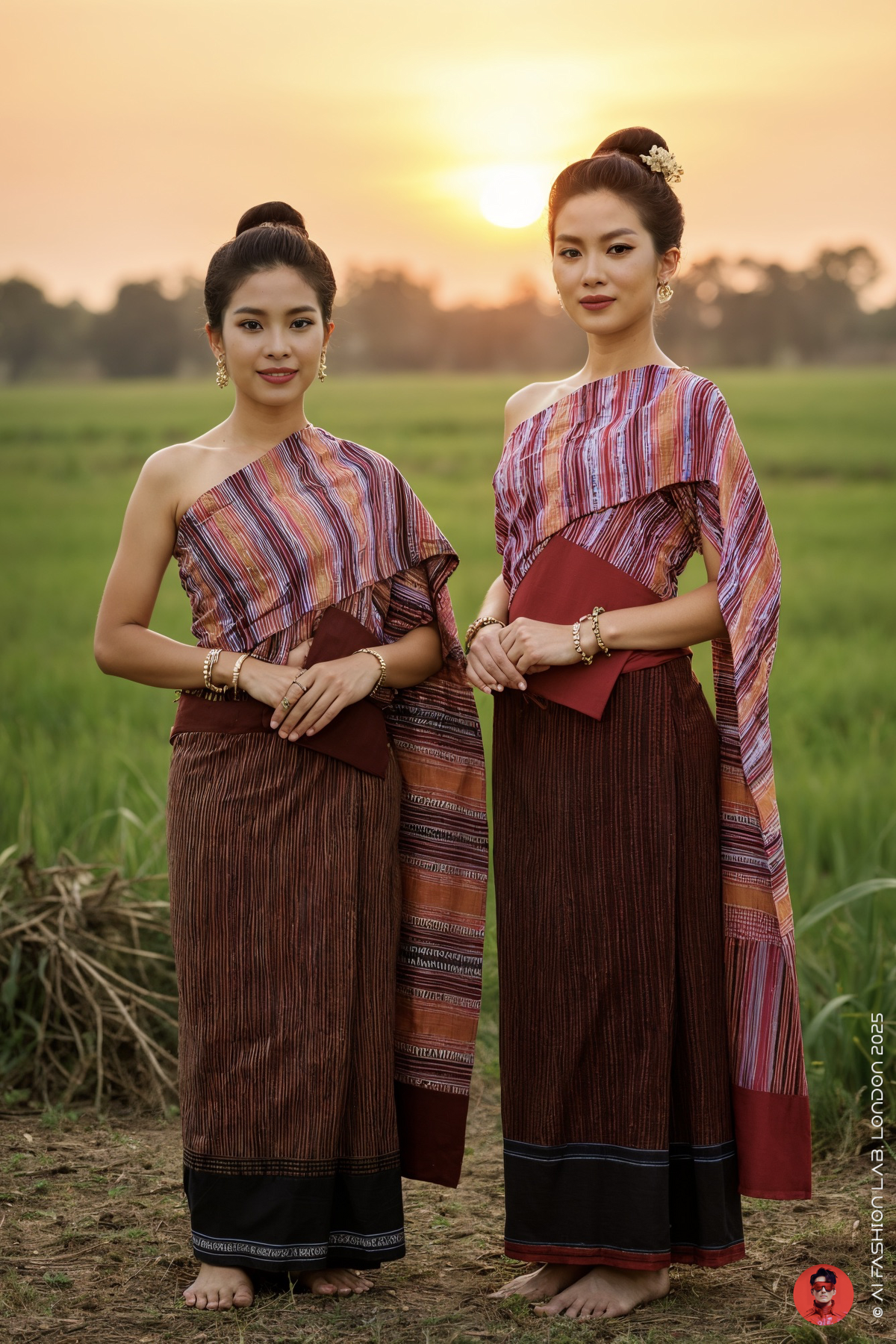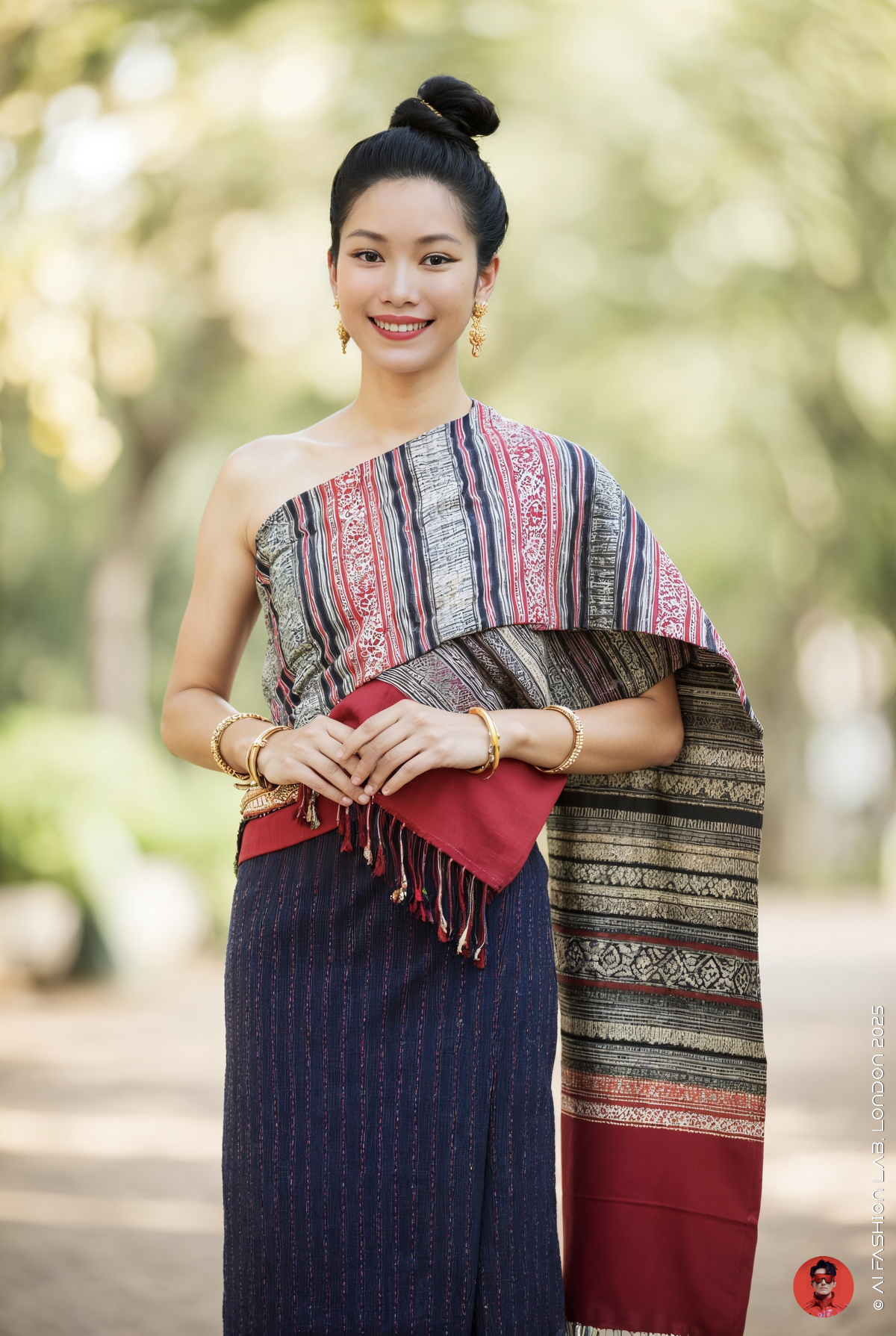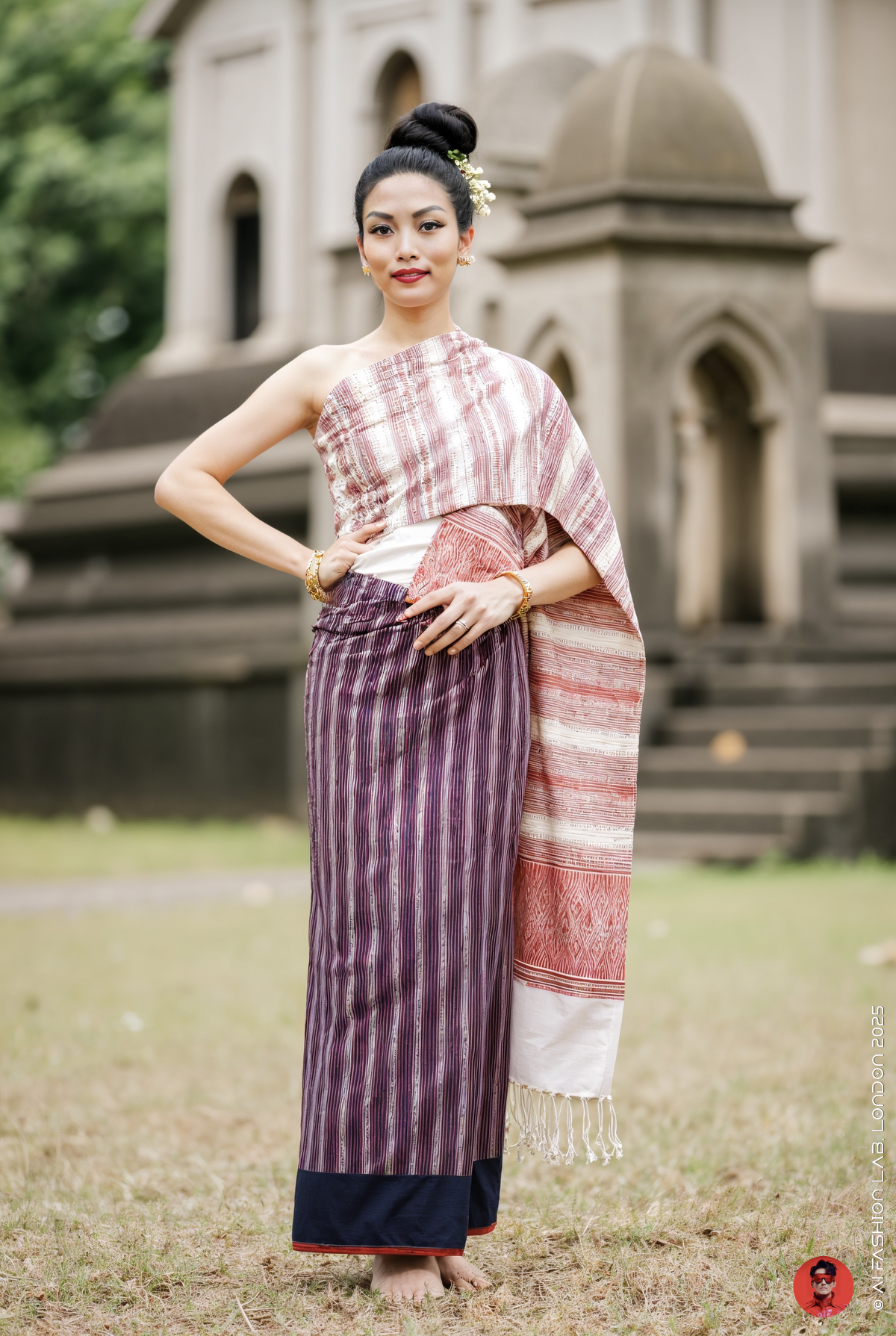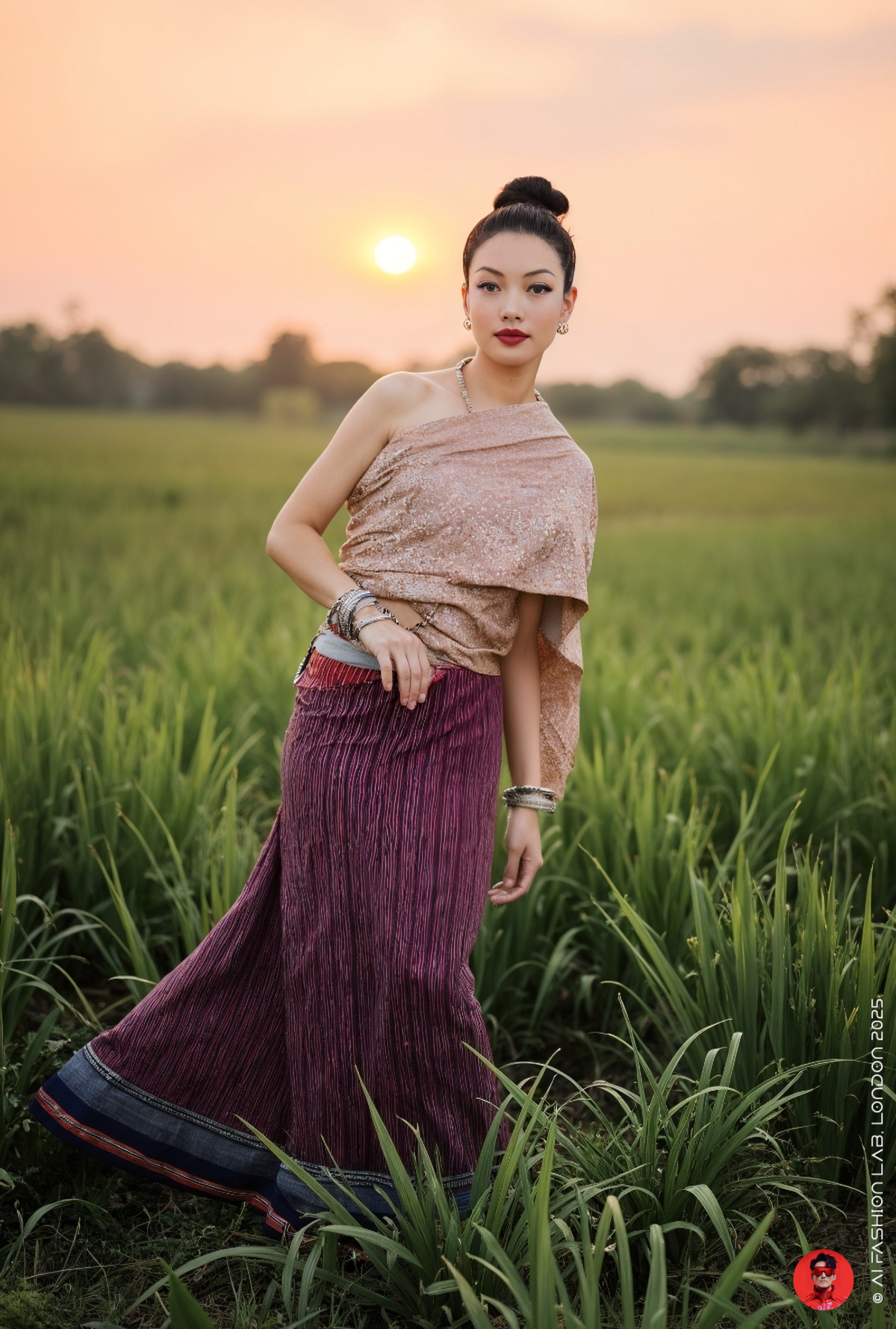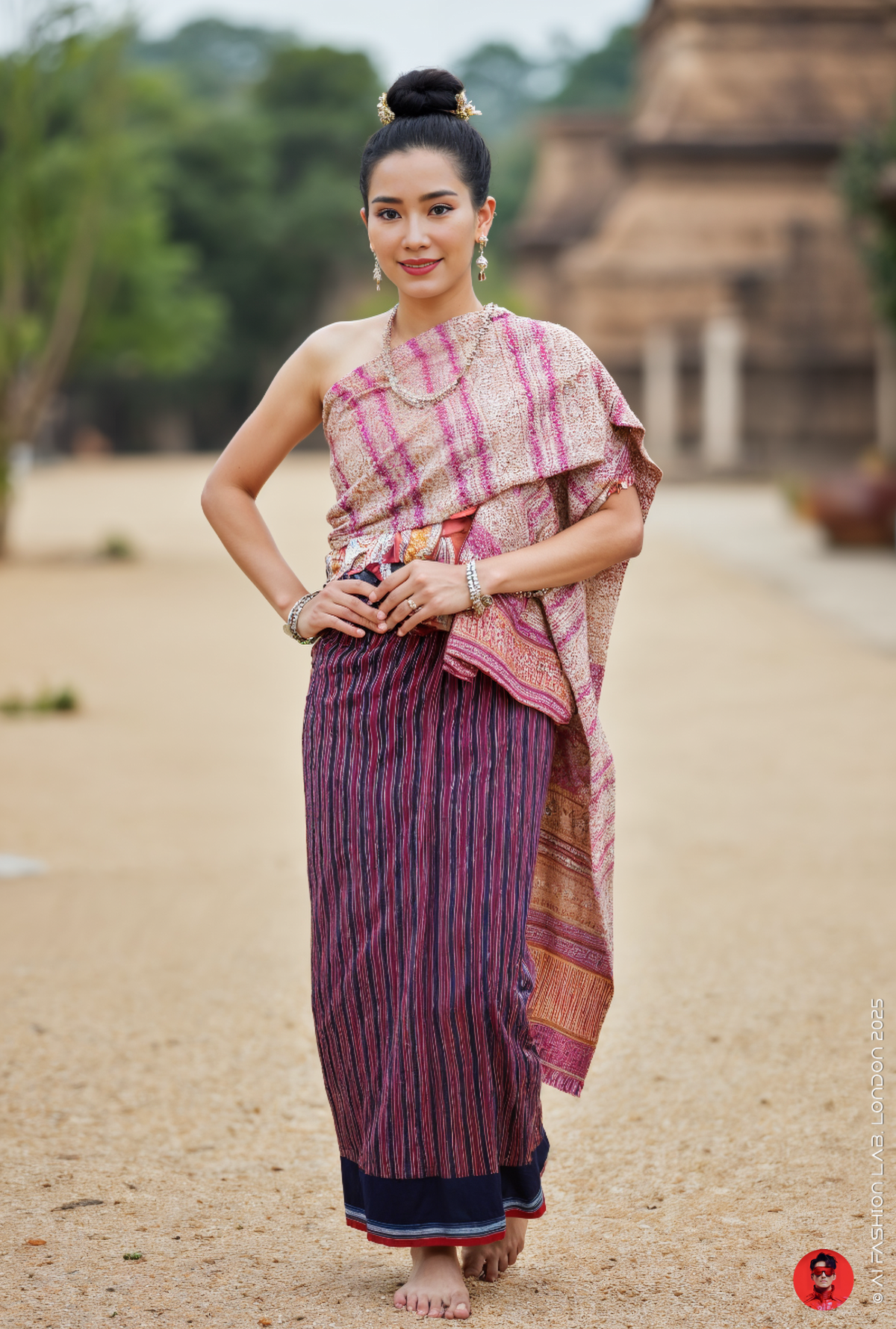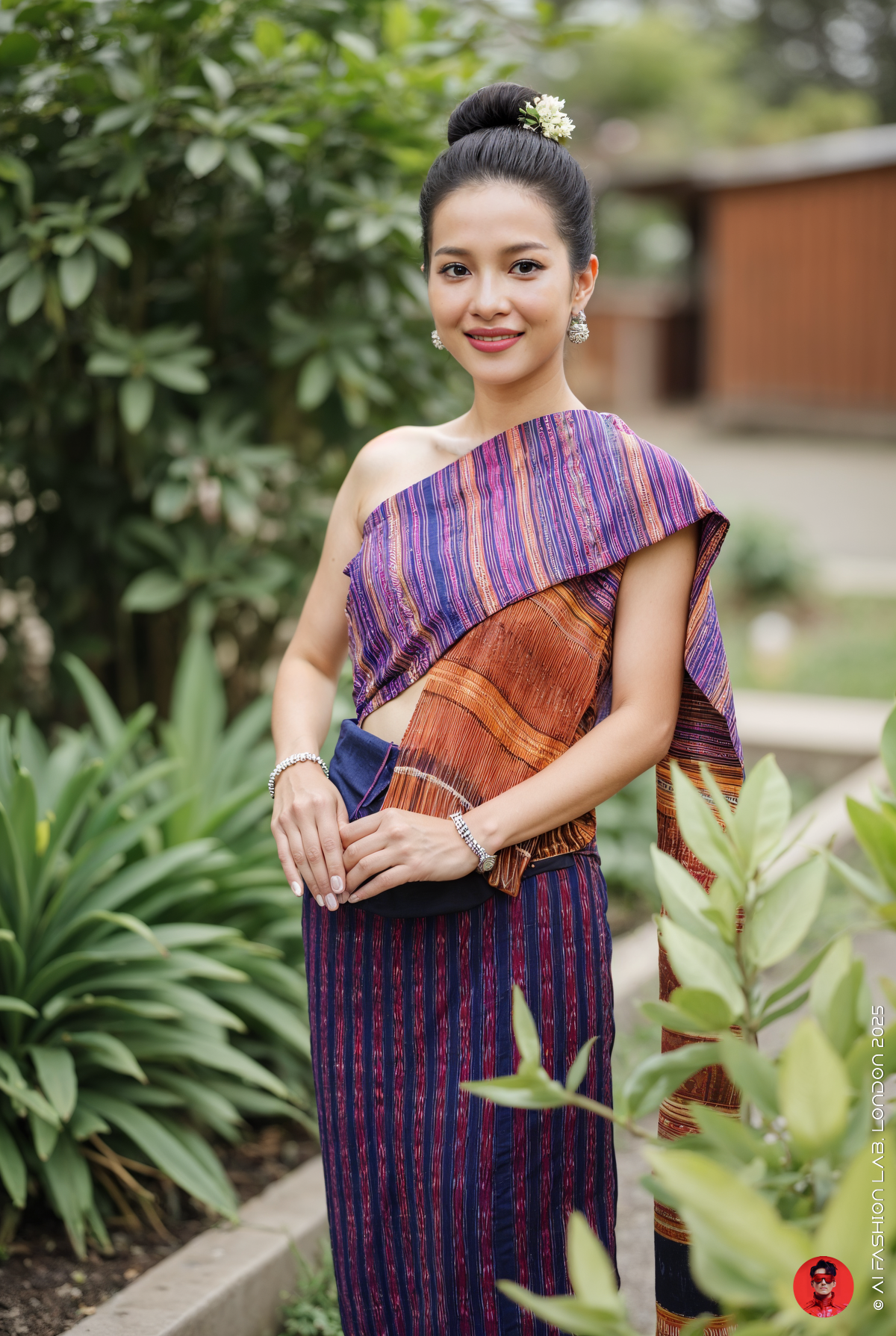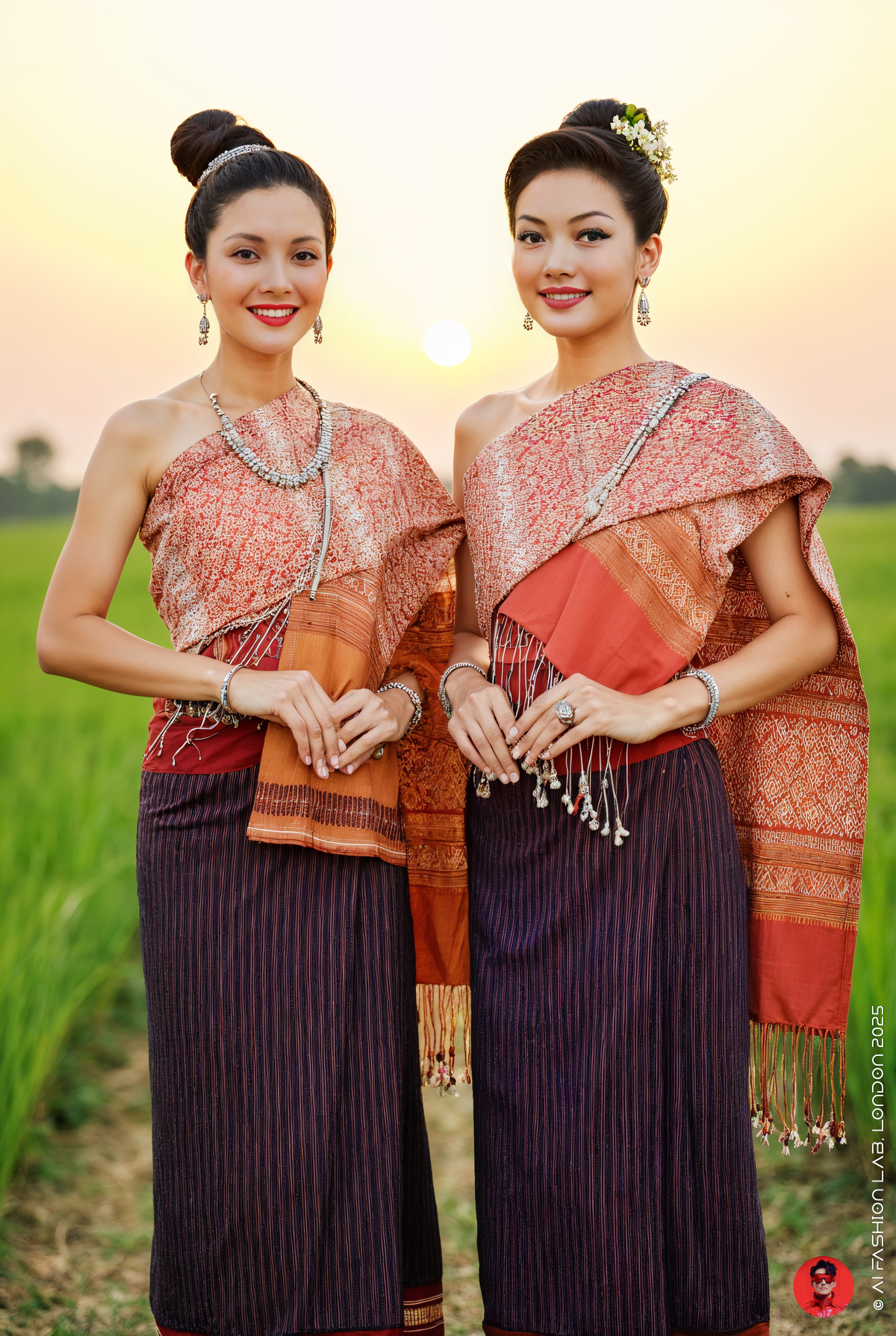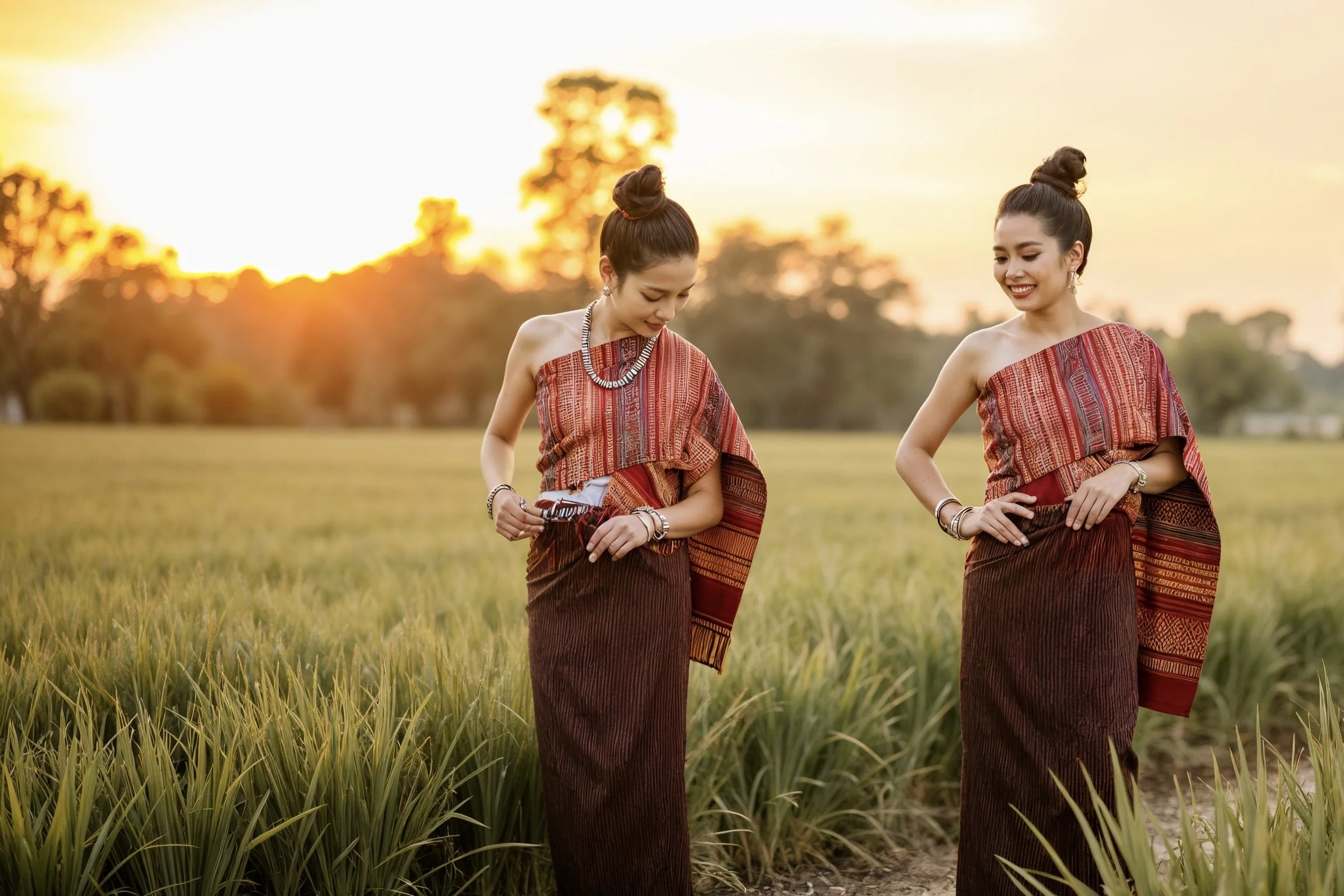การแต่งกายของสตรีภาคอีสาน
การแต่งกายของสตรีภาคอีสาน
คอลเลกชันภาพที่สร้างสรรค์ด้วยเทคโนโลยี AI ชุดนี้ ถ่ายทอดการแต่งกายแบบดั้งเดิมของสตรีชาวอีสานและผ้าทอพื้นเมือง ซึ่งถือเป็นมรดกทางวัฒนธรรมอันทรงคุณค่าของประเทศไทย ประเทศไทยเป็นแผ่นดินที่อุดมด้วยความหลากหลายทางวัฒนธรรม และการแต่งกายรวมถึงผ้าทอจากภาคอีสานก็มีความงดงามโดดเด่นไม่แพ้ภูมิภาคอื่น ๆ ของประเทศ คอลเลกชันนี้สร้างสรรค์จากการฝึกโมเดล AI ด้วยชุดข้อมูลเกี่ยวกับการแต่งกายและผ้าพื้นเมืองอีสาน เพื่อให้ได้ผลลัพธ์ที่แม่นยำและสะท้อนความสมจริงในการถ่ายทอดเอกลักษณ์ของสไตล์การแต่งกายและศิลปะการทอผ้าของภูมิภาคนี้
ผ้าพื้นเมืองอีสานถือเป็นมรดกทางวัฒนธรรมที่ฝังแน่นอยู่ในวิถีชีวิตของผู้คนในภาคตะวันออกเฉียงเหนือของไทย การทอผ้าไม่ใช่เพียงงานฝีมือเพื่อการใช้สอย หากแต่เป็นกิจกรรมที่สะท้อนความผูกพันระหว่างครอบครัว ชุมชน และวิถีชีวิตชนบท การทอผ้ามักกระทำในยามว่างหลังเสร็จสิ้นฤดูการทำนาหรือหลังจากงานประจำ ใต้ถุนบ้านของชาวอีสานแทบทุกหลังจะกางหูกทอผ้า โดยผู้หญิงเป็นผู้สืบทอดภูมิปัญญานี้มาตั้งแต่วัยเด็ก ผ่านการจดจำและการฝึกฝนจริง ทั้งการเรียนรู้เรื่องลวดลาย สีสัน เทคนิคการย้อม และวิธีการทอ ผ้าที่ทอด้วยมือนอกจากจะถูกนำมาใช้ตัดเย็บเป็นเสื้อผ้า หมอน ที่นอน และผ้าห่มแล้ว ยังมีนัยสำคัญทางวัฒนธรรมด้วย เพราะหญิงสาวจำเป็นต้องทอผ้าเก็บไว้สำหรับการออกเรือน ทั้งสำหรับตนเองและเจ้าบ่าว การทอผ้าจึงถูกมองว่าเป็นเครื่องพิสูจน์ความเป็นกุลสตรีและความพร้อมในบทบาทของแม่เหย้าแม่เรือน
ผ้าพื้นเมืองอีสานสามารถแบ่งออกเป็นสองประเภทใหญ่ ๆ ประเภทแรกคือผ้าที่ทอขึ้นเพื่อใช้ในชีวิตประจำวัน ซึ่งมักเป็นผ้าพื้นเรียบไม่มีลวดลาย เน้นความทนทานและนิยมใช้ฝ้ายย้อมสีตามต้องการ อีกประเภทคือผ้าที่ทอขึ้นสำหรับโอกาสพิเศษ เช่น งานบุญ งานแต่งงาน หรือการฟ้อนรำ ซึ่งจะมีลวดลายวิจิตรและสีสันหลากหลายที่สะท้อนความงดงามและความประณีตของผู้ทอ การทอผ้ายังสัมพันธ์อย่างใกล้ชิดกับประเพณี “การลงข่วง” ซึ่งเป็นการรวมกลุ่มของหญิงสาวในหมู่บ้าน มานั่งสาวไหม ปั่นฝ้าย และกรอด้ายร่วมกันรอบกองไฟ ขณะเดียวกันชายหนุ่มก็จะถือโอกาสเข้ามาพูดคุย เกี้ยวพาราสี และสร้างบรรยากาศคึกคัก เสียงพิณ แคน และโหวต รวมถึงการจ่ายผญาโต้ตอบกันทำให้ค่ำคืนแห่งการทอผ้าเต็มไปด้วยชีวิตชีวา
ความหลากหลายทางวัฒนธรรมในภาคอีสานส่งผลให้ผ้าที่ผลิตในแต่ละท้องถิ่นมีลักษณะแตกต่างกัน ชาวอีสานเหนือส่วนใหญ่เป็นชนเชื้อสายลาวจากลุ่มแม่น้ำโขง รวมทั้งมีกลุ่มชาติพันธุ์ข่า ผู้ไท โส้ แสก กระเลิง และย้อ กลุ่มไทยลาวเหล่านี้ถือว่ามีบทบาทสำคัญที่สุดในการทอผ้าพื้นเมือง โดยใช้ทั้งฝ้ายและไหม แม้ปัจจุบันจะเริ่มมีการนำเส้นใยสังเคราะห์มาทอร่วมด้วยก็ตาม ผ้าที่เป็นเอกลักษณ์ของอีสานเหนือ ได้แก่ ผ้ามัดหมี่ ผ้าขิด และผ้าแพรวา ผ้ามัดหมี่เป็นศิลปะการทอที่ใช้เทคนิคมัดย้อมเส้นด้ายก่อนนำไปทอ เกิดเป็นลวดลายที่มีเอกลักษณ์จากรอยซึมและการเหลื่อมของเส้นด้าย ลายพื้นฐานมีเจ็ดลาย ได้แก่ หมี่ขอ หมี่โคม หมี่บักจัน หมี่กงน้อย หมี่ดอกแก้ว หมี่ข้อ และหมี่ใบไผ่ ลวดลายเหล่านี้ได้แรงบันดาลใจจากธรรมชาติ เช่น ใบไม้ ดอกไม้ และสัตว์ แหล่งผลิตที่ขึ้นชื่อได้แก่ อำเภอชนบท จังหวัดขอนแก่น และอำเภอบ้านเขวา จังหวัดชัยภูมิ ขณะที่ผ้าขิดเป็นผ้าที่ทอโดยการใช้ไม้เขี่ยเส้นยืนขึ้นตามจังหวะเพื่อสร้างลวดลายคล้ายเครื่องจักสาน กระบวนการนี้เรียกว่า “การเก็บขิด” มากกว่าการ “ทอขิด” ผ้าขิดมีหลายประเภทตามการใช้งาน เช่น ผ้าตีนซิ่น ผ้าหัวซิ่น และผ้าแพรวา ซึ่งในบางพื้นที่ยังทอเป็นผ้าแพรมนขนาดเล็กสำหรับใช้เช็ดหน้าหรือโพกผมของหญิงสาวผู้ไท นอกจากนี้ยังมีผ้าลายน้ำไหลที่ได้รับอิทธิพลจากซิ่นน่านของภาคเหนือ โดยทอเป็นริ้วใหญ่สลับสี 3–4 สี พร้อมแทรกลายขิดในบางช่วง และผ้าโสร่งสำหรับผู้ชายซึ่งทอด้วยไหมหรือฝ้าย มีลายตาหมากรุกเล็กและใหญ่สลับกัน
ในอีกด้านหนึ่ง ชาวอีสานใต้ซึ่งเป็นกลุ่มคนไทยเชื้อสายเขมรในจังหวัดสุรินทร์ ศรีสะเกษ และบุรีรัมย์ ก็มีรูปแบบการทอผ้าที่แตกต่างออกไป ลักษณะเด่นคือการใช้สีจากธรรมชาติไม่กี่ชนิด ทำให้ผ้ามีโทนสีที่นุ่มนวลและไม่ฉูดฉาดเหมือนกลุ่มไทยลาว ถึงแม้จะมีการทอผ้ามัดหมี่เช่นกัน แต่ลวดลายไม่โดดเด่นนัก เอกลักษณ์ที่แท้จริงของอีสานใต้กลับสะท้อนผ่านผ้าประเภทอื่น เช่น ผ้าหางกระรอกที่ใช้เส้นไหมสองสีควั่นทบกันแล้วทอ ทำให้เกิดประกายเลื่อมมันวาว ผ้าปูมซึ่งเป็นผ้ามัดหมี่ที่มีเทคนิคเฉพาะถิ่นแตกต่างจากแหล่งอื่น ผ้าเซียมหรือผ้าลุยเซียมที่นิยมในหมู่ผู้สูงอายุ และผ้าขิดที่ทอด้วยฝ้ายหรือไหม ซึ่งมักใช้ต่อเป็นตีนซิ่นโดยเฉพาะในครอบครัวที่มีฐานะดี ลักษณะการต่อผ้าในกลุ่มอีสานใต้ยังแตกต่างจากไทยลาวอย่างชัดเจน เพราะจะต่อเชิงเข้ากับตัวซิ่นก่อนแล้วจึงต่อเป็นตีนซิ่นในภายหลัง
เมื่อเปรียบเทียบแล้ว ผ้าพื้นเมืองของทั้งอีสานเหนือและอีสานใต้ต่างมีเอกลักษณ์ร่วมคือการทอเป็นลายยาวขนานกับลำตัว ซึ่งต่างจากซิ่นล้านนาที่นิยมลายขวางและยาวกรอมเท้า ผู้หญิงไทยลาวนิยมสวมซิ่นสูงระดับเข่า แต่ไม่สั้นเท่าซิ่นของผู้หญิงเวียงจันทน์และหลวงพระบาง การต่อหัวซิ่นและตีนซิ่นในกลุ่มไทยลาวมักใช้ผ้าชนิดเดียวกัน โดยหัวซิ่นมักเป็นไหมทอขิดลายโบคว่ำ–โบหงายบนพื้นสีแดง การนุ่งซิ่นนิยมป้ายหน้าเพื่อซ่อนตะเข็บ แตกต่างจากกลุ่มไทยเชื้อสายเขมรที่มักทอริมผ้าเป็นริ้วสีหลากหลายไปตามแนวตะเข็บ เมื่อสวมใส่แล้วตะเข็บจะกลมกลืนกับลายผ้าและมักถูกจัดวางไว้บริเวณสะโพก
สำหรับผู้หญิงชาวอีสาน ผ้าซิ่นยังสะท้อนถึงสถานภาพสมรสได้อย่างชัดเจน ซิ่นของผู้หญิงที่แต่งงานแล้วมักประกอบด้วยสามส่วน ได้แก่ หัวซิ่น ตัวซิ่น และตีนซิ่น หัวซิ่นมีความกว้างประมาณยี่สิบเซนติเมตร ยาวเท่าตัวซิ่น ทอเป็นลายขวางสลับเส้นไหมสีเล็ก ๆ สวยงามละเอียด ตัวซิ่นเป็นส่วนกลางที่กว้างที่สุด นิยมทอเป็นลายมัดหมี่ ส่วนตีนซิ่นกว้างเพียงสิบเซนติเมตรและทอให้ลวดลายตรงข้ามกับหัวซิ่น โดยลวดลายมักได้รับแรงบันดาลใจจากธรรมชาติ เช่น ลายงูที่เป็นปล้องสีเหลืองและดำ ขณะที่ซิ่นของหญิงสาวโดยมากเป็นผ้ามัดหมี่ผืนเดียวตลอดทั้งผืน ลวดลายต่อเนื่องไม่แยกเป็นสามส่วน และที่ริมขอบล่างของซิ่นจะมีเชิงซิ่นที่ทอเป็นลายสัตว์มงคล เช่น ลายไก่ฟ้าหรือหงส์ทอง
ในมิติของภาษาและการแต่งกาย ภาษาถิ่นอีสานมีสำเนียงใกล้เคียงกับภาษาลาว มีคำที่ใช้กันอย่างแพร่หลาย เช่น “เว้า” (พูด) “แซบ” (อร่อย) “เคียด” (โกรธ) และ “นำ” (ด้วย) ส่วนในด้านเครื่องแต่งกาย ชาวอีสานยังคงยึดโยงกับผ้าทอมือที่ผลิตจากเส้นใยธรรมชาติ โดยเฉพาะผ้าฝ้ายและผ้าไหม อันเป็นรากฐานสำคัญที่เชื่อมโยงทั้งวิถีชีวิต วัฒนธรรม และอัตลักษณ์ของผ้าพื้นเมืองอีสานมาจนถึงปัจจุบัน
Traditional Textiles of Isan
This collection of AI-generated images portrays the traditional dress of Isan women and their handwoven textiles, which are regarded as a treasured part of Thailand’s cultural heritage. Thailand is a land rich in cultural diversity, and the clothing and woven fabrics from the Isan region are as striking and beautiful as those of any other part of the country. The collection was created by training an AI model with a dataset of traditional Isan dress and textiles, with the aim of achieving greater accuracy and authenticity in representing the region’s distinctive clothing styles and weaving traditions.
The traditional textiles of Isan, in northeastern Thailand, represent a cultural heritage deeply rooted in the daily lives of its people. Weaving has long been more than a domestic craft; it is an activity that embodies the rhythms of agrarian life, social interaction, and feminine virtue. After the rice harvest or when daily labour eased, women in almost every household would set up looms beneath their stilted homes to weave cloth. This knowledge was passed down from mother to daughter, beginning in childhood through memorisation and hands-on practice—mastering patterns, colours, dyeing, and weaving techniques. Handwoven cloth was used for garments, pillows, mattresses, and blankets, but its significance reached further. For young women, weaving was part of their preparation for marriage, producing cloth for themselves and for their future husbands. Thus, weaving came to symbolise refinement, diligence, and readiness for the role of housewife and mother.
Isan textiles can be divided broadly into two categories. The first consists of cloth for everyday use, usually plain and undecorated, woven from cotton and dyed for durability. The second encompasses cloth for special occasions—temple festivals, weddings, and traditional dances—characterised by intricate patterns and vibrant colours, showcasing the weaver’s artistry and skill. Weaving was also closely tied to the communal custom of long khuang (ลงข่วง), when village girls gathered around a fire to reel silk, spin cotton, and wind yarn together. Young men would join in, chatting and courting, while music from the phin (พิณ – lute), khaen (แคน – bamboo mouth organ), and whot (โหวต – panpipe) accompanied lively exchanges of phaya (ผญา – folk poetry). In this way, weaving was both a household duty and a vibrant social tradition.
Because of the cultural diversity within Isan, the textiles vary widely between regions and ethnic groups. In northern Isan, the population is predominantly Lao in origin, with additional groups such as Kha, Phu Tai (ผู้ไท), So, Saek (แสก), Kaleung (กระเลิง), and Yor (ย้อ). This Lao-Isan group has played the most significant role in textile production, traditionally working with cotton and silk, though synthetic fibres are sometimes incorporated today. The distinctive textiles of northern Isan include Pha Mudmee (ผ้ามัดหมี่), Pha Khid (ผ้าขิด), and Pha Praewa (ผ้าแพรวา).
Pha Mudmee (ผ้ามัดหมี่) is an art of weaving based on the tie-dyeing of threads before weaving. Its beauty lies in the blurred edges of the colours and the irregular overlaps of threads that create intricate motifs on the loom. This technique requires great skill and is handed down from ancestors. There are seven fundamental patterns: Mi Kho (หมี่ขอ), Mi Khom(หมี่โคม), Mi Bak Chan (หมี่บักจัน), Mi Kong Noi (หมี่กงน้อย), Mi Dok Kaew (หมี่ดอกแก้ว), Mi Kho (หมี่ข้อ), and Mi Bai Phai (หมี่ใบไผ่). These designs were inspired by nature, such as leaves, flowers, and animals. Famous weaving centres include Chonnabot District in Khon Kaen and Ban Khwao District in Chaiyaphum.
Pha Khid (ผ้าขิด) is created by lifting warp threads with a stick in a set rhythm before passing the weft across, forming patterns reminiscent of basketry. This process is called keb khid (เก็บขิด – “picking khid”), rather than simply weaving. Three common types reflect their use: Pha Teen Sin (ผ้าตีนซิ่น) for the lower border of skirts, Pha Hua Sin (ผ้าหัวซิ่น) for the upper border, and Pha Praewa (ผ้าแพรวา), a silk or cotton cloth about 1.5–2 metres long, treasured by the Phu Tai. A smaller version, Pha Phaemon (ผ้าแพรมน), square in shape, is often used as a kerchief or headscarf by Phu Tai women.
Other northern textiles include Pha Lai Nam Lai (ผ้าลายน้ำไหล), inspired by northern Thai sin nan (ซิ่นน่าน), which features broad vertical stripes in alternating colours with khid patterns woven in between, and Pha Sarong (ผ้าโสร่ง), a men’s wrap-around cloth woven in checks, about one metre wide and two metres long, sewn into a tube.
In contrast, southern Isan, where Thai-Khmer communities reside in Surin, Si Sa Ket, and Buri Ram, is known for textiles with subtler tones. These are usually dyed with only a few natural colours, creating softer effects distinct from the more vivid Lao-Isan cloths. While Pha Mudmee (ผ้ามัดหมี่) is also woven here, the standout fabrics are of other types. Pha Hang Karok (ผ้าหางกระรอก), or “squirrel-tail cloth,” shimmers with lustre as two differently coloured silk threads are twisted together and woven. Pha Poom (ผ้าปูม) is a unique local variation of mudmee, with designs not found elsewhere. Pha Siam or Luy Siam (ผ้าเซียม / ลุยเซียม) is a silk cloth favoured by the elderly, while Pha Khid (ผ้าขิด) is woven in both cotton and silk but used mostly by wealthier families to extend the teen sin (ตีนซิ่น – lower skirt border). Unlike the Lao-Isan method, Khmer-style weaving attaches the cheung (เชิง – hem) to the body first, then adds the teen sin, creating a distinctive layered structure.
Despite these regional differences, Isan textiles share a characteristic: patterns are usually woven lengthwise, parallel to the body. This sets them apart from Lanna pha sin (ผ้าซิ่น), which feature crosswise stripes and often extend to the ankles. Lao-Isan women typically wear skirts reaching to the knees—shorter than Lanna skirts, though longer than those worn in Vientiane or Luang Prabang. Lao groups usually match hua sin (หัวซิ่น – upper border) and teen sin (ตีนซิ่น – lower border) with cloth of the same type, with hua sin often woven from silk in khid patterns of inverted and upright bows on a red ground. The skirt is wrapped so the seam is hidden in front. Khmer-influenced groups in southern Isan, however, often weave multi-coloured stripes into the seam itself, positioning it at the hip so that it blends naturally into the design.
For women, the pha sin (ผ้าซิ่น – tubular skirt) also reflects marital status. Married women’s skirts are usually made of three distinct sections: the hua sin (หัวซิ่น – upper band), about 20 cm wide, woven with horizontal designs and colourful silk inserts; the tua sin (ตัวซิ่น – body), the central and widest part, often decorated with mudmee motifs; and the teen sin(ตีนซิ่น – lower band), about 10 cm wide, often contrasting with the hua sin and sometimes inspired by nature, such as snake-skin patterns of alternating yellow and black. By contrast, young women’s skirts are usually woven as a single continuous piece of mudmee, with motifs running throughout. At the lower hem, or cheung sin (เชิงซิ่น), designs often depict auspicious animals such as the pheasant (kai fa – ไก่ฟ้า) or golden swan (hong thong – หงส์ทอง).
The language and clothing traditions of Isan go hand in hand. The dialect closely resembles Lao, with common words such as wao (เว้า – speak), saep (แซบ – delicious), khiat (เคียด – angry), and nam (นำ – with). In dress, Isan people continue to rely on handwoven textiles of natural fibres, especially cotton (pha fai – ผ้าฝ้าย) and silk (pha mai – ผ้าไหม). These materials remain the foundation of Isan’s textile heritage, embodying the blend of daily life, cultural values, and regional identity that traditional weaving continues to preserve.
#aifashionlab #AI #aiartist #aiart #aifashion #aifashiondesign #aifashionstyling #aifashiondesigner #fashion #fashionhistory #historyoffashion #fashionstyling #fashionphotography #digitalfashion #digitalfashiondesign #digitalcostumedesign #digitaldesign #digitalaiart #ThaiFashionHistory #ThaiFashionAI #thailand #UNESCO
















